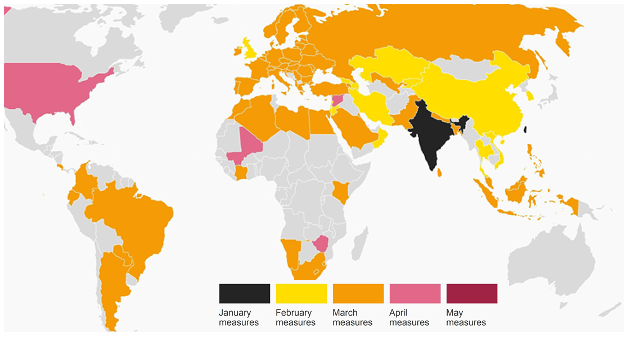International trade has been essential to pandemic-fighting efforts by nations across the globe. For example, during the critical phase of their outbreaks, Western nations were able to import millions of masks and other personal protective equipment (PPE) from Asian nations who were recovering from their initial outbreaks and lockdowns (Bown 2020a, Fiorini et al 2020). China was the source of about half of US PPE imports before COVID. Chinese exports of PPE to the US fell by 19% (relative to the same period last year) when it was suffering its worst outbreak, but with workers returning to factories from March, China rapidly scaled up production and exports. By late March, it was making 12 times more masks than it was making in 2019 (Bown 2020b). Moreover, buyers in the West have been able to import from non-traditional exporters such as Sri Lanka, Thailand, Dominican Republic, Honduras, and Vietnam (Bamber et al 2020).
Despite the positive role trade has played, the COVID crisis has witnessed the rise of several protectionist policies (González 2020). For instance, many nations imposed export restrictions on medical supplies in an effort to boost local availability (Figure 1). And the possibilities of further and wider trade restrictions have multiplied as US-China trade tensions have reignited.
More broadly, some policymakers are calling for greater self-reliance in general and repatriation of international supply chains in particular. The US Trade Representative Robert Lighthizer wrote last week, “businesses have been rethinking the way that overextended, overseas supply lines expose them to unacceptable risk … the era of reflexive offshoring is over… ” (Lighthizer 2020). Similar sentiments were expressed in a 17 April 2020 resolution in which the European Parliament declared it “supports the reintegration of supply chains inside the EU” (European Parliament 2020).
In this column, we argue that policies geared towards restricting exports and dismantling supply chains could backfire with negative consequences for trade in both the short and long term – and not just trade in medical equipment. Our argument is based on three facts. First, the interdependence of national manufacturing sectors is pervasive. Second, it has grown substantially in recent years. And third, China plays a unique role in the global network of trade in intermediate inputs.
Figure 1 Export controls on medical supplies and medicines reported in 2020: 83 nations have imposed a total of 150 measures

Source: Global Trade Alert website, https://www.globaltradealert.org/, accessed 9 May 2020.
Concluding remarks
If the world is to ramp up the production of essential medical equipment to meet the swift rise in pandemic-driven demand, there is no alternative to international trade given the integrated nature of global manufacturing. The same is true for medicines, vaccines, and medical tests that will become important in defeating the virus. Trying to shut down this sort of supply-chain trade will simply make it harder to fight the virus for all nations.
Whatever merits there may be to addressing risk in international supply chains, pursuing this goal in the midst of a pandemic could lead to serious, unintended consequences. Pursuing policies aimed at forcing companies to alter their supply chain practices can easily lead other nations to respond. A spiral of retaliation could disrupt world productive capacity in virtually all manufacturing sectors given the high level of interdependence we documented. This could make economic recovery more challenging, to say the least. In short, keeping trade channels open will help us fight the disease and help the world economy recover.
To view the original blog post at VOX CEPR Policy Portal, please click here
